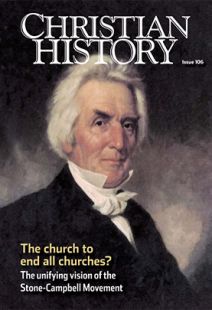Climbing into the mainline boat
IT WAS JUNE 1811. Alexander Campbell, preaching at Brush Run Church on Job 8:6–7, issued a clarion call against human structures, human rules, and “ignorance and superstition”: “We commence our career as a church under the banner of ‘the Bible, the whole Bible, and nothing but the Bible’ as the standard of our religious faith and practice. . . . Christians are the sons of liberty—the Lord’s freed men.”
Row, row, disciples boat
Yet, ironically, over the course of the next two centuries, the stream of Campbell’s movement today known as the Christian Church (Disciples of Christ) somehow emerged as the largest mainline Protestant denomination born in America. How did this stream become a mainline tributary?
Near the end of the nineteenth century, increasing numbers of Disciples ministers became familiar with the higher-critical approach to the Bible emerging in Germany. This approach challenged many of the early movement’s traditional assumptions related to the Bible. Did Paul write the letters attributed to him? How much do the Gospels really tell us about Jesus?
Herbert L. Willett, dean of the Disciples House at the University of Chicago after 1894 and a prolific popular writer, led the charge to spread a new liberal vision of American Protestantism among Disciples laity.
Willett emphasized Christ’s teachings over church declarations. He loved to tell the Bible’s stories. For him, the authority of the Bible rested in how God made a difference in people’s lives, not in literal allegiance to the words on the page.
But hearts as well as minds were involved in the shift. By 1900 Disciples embraced social gospel trends, emphasizing the church’s need to solve social problems rather than defend doctrinal statements.
By 1940 these trends were attracting the majority of some 350 Disciples ministers studying at mainline seminaries like the University of Chicago and Yale. At least 48 Disciples ministers had also received PhDs from these schools.
As Disciples sailed this mainline stream, they grew to over 1,000,000 members at their 1909 centennial. They attributed their growth to their vision of Christian unity, but cultural factors also played a role.
In 1881 one of their own, James A. Garfield, was elected president. Their 11,000 congregations represented a central cultural position. They claimed 27 colleges and 3 missionary societies, and their National Benevolent Society provided significant benefits for orphans, widows, the aging, and the poor. The Disciples had arrived.
When, in 1908, mainline Protestants organized the Federal Council of the Churches of Christ (33 denominations that represented more than 18,000,000 church members), they included the Disciples, even though the Disciples possessed no organizational structure to affirm their membership. Their course down the mainline stream was set.
In 1968 the Disciples finally restructured to formally recognize the “denominational” character of their own work. Their first moderator, Ronald Osborn, wryly noted that the Disciples had officially made it to the mainline just as the mainline was ending. But Disciples leaders had really counted themselves mainline long before.
Through it all, though, the Disciples emphasized particular themes historically consistent with their earliest beliefs. They remain a people of the Book. Though they are less likely to affirm biblical literalism than other Stone-Campbell streams, most Disciples still emphasize the central role the Bible plays in Christian life.
They affirm the unity of the church as resting upon the common Christian confession of Christ rather than the authority of the institutional church. While they no longer believe the church is unchanged by time or social context, today’s Disciples still affirm the church belongs to God, not to its membership, and must serve the mission of God within history.
And they still believe God is in the business of redeeming human history, perhaps one reason they have always been a sacramental people. Baptism remains, as Campbell put it, an “embodiment of the gospel” where Christians affirm the grace of God, identify with the burial and resurrection of Christ, and are born into God’s family.
The Lord’s Supper, still practiced weekly in the majority of congregations, “inscribes the image of God” upon every Christian, as Campbell also said. Disciples still believe the Supper connects them with the community of faith, brings to mind the hope of God’s final victory, and reminds them that the healing of creation is not yet complete. CH
By Mark G. Toulouse
[Christian History originally published this article in Christian History Issue #106 in 2013]
Mark G. Toulouse is principal and professor of the history of Christianity at Emmanuel College and in the Department for the Study of Religion at the University of Toronto. He is the author of numerous books on Disciples history and theology.Next articles
Christian History Timeline: From Stone and Campbell to the Great Communion
The unity movement begun by Stone and the Campbells soon encountered division
Compiled by McGarvey Ice and the editorsSupport us
Christian History Institute (CHI) is a non-profit Pennsylvania corporation founded in 1982. Your donations support the continuation of this ministry
Donate



